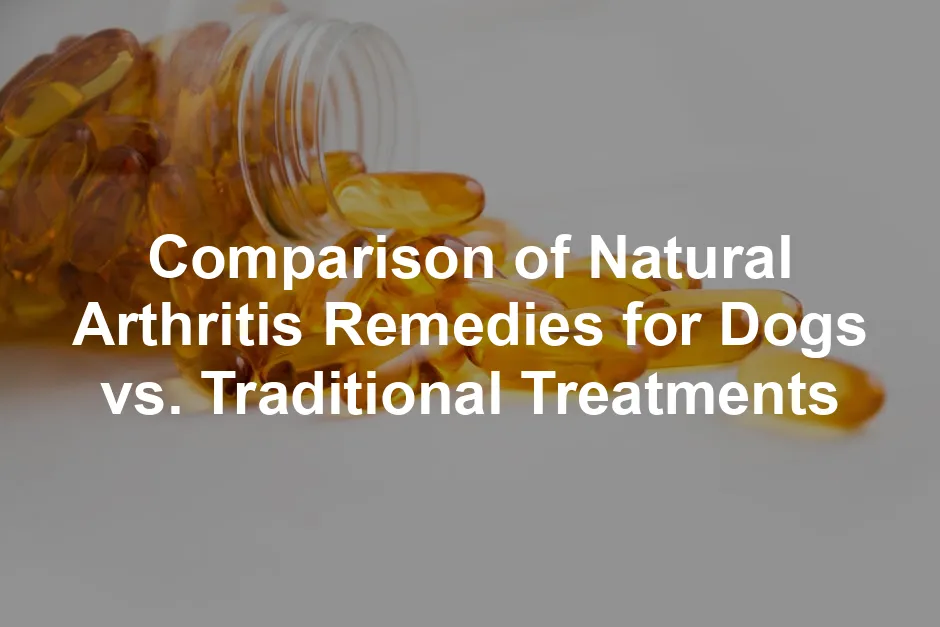Introduction
Arthritis in dogs is a tough pill to swallow. Watching your furry friend struggle with joint pain is heart-wrenching. This common ailment can impact any dog, but older pups are particularly vulnerable. As a loving pet owner, you want to find the best treatment to keep your companion happy and healthy. The good news is that you have options!
The treatment landscape is diverse, ranging from traditional medications to holistic, natural remedies. But how do you decide what’s best for your dog? This guide will help you weigh the pros and cons of natural arthritis remedies versus traditional treatments. By the end, you’ll be better equipped to make an informed decision that keeps your pup’s tail wagging.
Traditional treatments often include non-steroidal anti-inflammatory drugs (NSAIDs), which can be effective but come with a laundry list of potential side effects. These medications may cause gastrointestinal issues or even long-term damage to organs. On the other hand, natural remedies like glucosamine, turmeric, and green-lipped mussel have gained popularity among pet owners. They promise to alleviate pain and inflammation while potentially promoting overall joint health. For more information on how to manage your dog’s arthritis pain, check out this article on natural remedies for dog arthritis pain relief.
Speaking of glucosamine, if you’re looking to give your dog a boost in joint health, consider adding a Glucosamine for Dogs to their diet. This supplement can help support their joint health and keep them moving like the pups they are.
Understanding the options available for managing arthritis can make a significant difference in your dog’s quality of life. Learn more about natural remedies for dog arthritis pain relief.
However, natural doesn’t always mean safe. Just like traditional treatments, these remedies can have side effects or interactions with other medications. Moreover, they often take longer to show results.
It’s crucial to consult your veterinarian before making any changes to your dog’s treatment plan. They can help you craft a tailored approach based on your dog’s specific needs. So, whether you lean towards traditional treatments, natural remedies, or a blend of both, this guide will help you navigate the options. Let’s keep those tails wagging and ensure your furry friend lives their best life!
Summary of Key Points
1. Understanding Canine Arthritis: Osteoarthritis is prevalent in dogs and can severely impact their quality of life.
2. Traditional Treatments:
- Non-Steroidal Anti-Inflammatory Drugs (NSAIDs): Common but can cause side effects.
- Corticosteroids and Opioids: Effective for pain relief but may lead to long-term risks.
3. Natural Remedies:
- Herbal Supplements: Glucosamine, turmeric, and green-lipped mussel are popular options.
- Diet and Lifestyle Changes: Weight management and exercise play key roles.
4. Comparative Efficacy: Studies show mixed results between natural and traditional treatments.
5. Veterinary Guidance: Always consult a veterinarian for a personalized treatment plan.
This section sets the stage for a deeper exploration of these treatment options, emphasizing the importance of informed decision-making. Your dog’s comfort and happiness are paramount, and understanding the available choices is the first step in ensuring they receive the best care possible.

Understanding Arthritis in Dogs
What is Canine Arthritis?
Arthritis is a term that refers to joint inflammation. This condition can affect dogs of any age, but older pups are particularly prone to it. The most common type is osteoarthritis (OA), often resulting from wear and tear over time. OA occurs when the cartilage cushioning the joints deteriorates, leading to painful friction between bones. This condition can create a cycle of pain and decreased mobility, severely impacting your dog’s quality of life.
Several factors contribute to the development of arthritis in dogs. Obesity is a significant risk factor, as excess weight adds stress to joints. Genetics also play a role, with certain breeds being more susceptible to joint problems. Injuries or developmental issues, such as hip dysplasia, can also lead to arthritis down the line. Furthermore, age is a critical factor, as the likelihood of arthritis increases as dogs grow older.

Symptoms of Arthritis
Recognizing the signs of arthritis in your dog is vital for early intervention. Common symptoms include:
- Difficulty standing up or lying down.
- Stiffness or limping, especially after rest.
- Reluctance to engage in physical activities or play.
- Changes in behavior, such as increased irritability or reluctance to be touched.
- Swollen joints or decreased range of motion.
If you notice any of these signs, it’s essential to consult your veterinarian for proper diagnosis and treatment options.
Traditional Treatments for Canine Arthritis
Overview of Traditional Treatments
When it comes to treating arthritis in dogs, traditional veterinary care often involves a mix of medications and lifestyle changes. The primary goal is to relieve pain and improve mobility. Here’s a closer look at some common pharmaceutical treatments.

Non-Steroidal Anti-Inflammatory Drugs (NSAIDs)
NSAIDs are typically the first line of defense against arthritis pain in dogs. They work by inhibiting enzymes that produce pain-causing substances in the body. This helps reduce inflammation and provides relief from discomfort. Popular NSAIDs prescribed include carprofen and meloxicam, which have been shown to effectively manage arthritis symptoms in many dogs.
However, it’s important to be aware of potential side effects. Some dogs may experience gastrointestinal issues, such as vomiting or diarrhea. Long-term use of NSAIDs can also pose risks to the kidneys and liver. Regular monitoring by your veterinarian is crucial to ensure your furry friend remains safe while on these medications.

Corticosteroids and Opioids
Corticosteroids, like prednisone, are sometimes prescribed for their potent anti-inflammatory effects. They can provide significant relief but are generally reserved for more severe cases due to potential long-term side effects, including weight gain and increased thirst.
Opioids, such as tramadol, may be used in conjunction with other treatments to manage more intense pain. However, these medications can lead to sedation and other adverse effects, making them less suitable for all dogs. Long-term use also raises concerns about potential dependency.
In summary, while traditional treatments can effectively manage arthritis in dogs, they come with their own set of risks. It’s crucial to maintain an open dialogue with your veterinarian about your dog’s specific needs and any potential side effects associated with these medications.
Natural Remedies for Dog Arthritis
Overview of Natural Remedies
Natural remedies for dog arthritis are becoming increasingly popular among pet owners. Many people are searching for gentler alternatives to traditional medications. These remedies often promise fewer side effects and a more holistic approach to health. As we become more aware of how our furry companions react to pharmaceuticals, natural treatments are stepping into the spotlight. Owners are now more curious about what nature has to offer in the battle against canine arthritis.

Herbal Supplements
Herbal supplements are at the forefront of natural treatments. Here are some common options pet owners are considering:
- Turmeric: This golden spice is known for its potent anti-inflammatory properties. Curcumin, a key ingredient, can help reduce joint pain and inflammation. You can easily find a Turmeric Curcumin Supplement to enhance your dog’s diet!
- Green-Lipped Mussel: Packed with omega-3 fatty acids, this marine delicacy is a powerhouse for joint health. It can help lubricate joints and reduce inflammation. Consider checking out a Green-Lipped Mussel Supplement for your pup!
- Glucosamine and Chondroitin: These two are like the dynamic duo of joint health. They are vital for maintaining cartilage and can help alleviate pain while promoting joint function. A great option is a Dog Joint Supplement with Chondroitin.

Dietary Changes
A balanced diet is essential for dogs suffering from arthritis. Foods rich in antioxidants and anti-inflammatory properties can significantly improve your pup’s well-being. Some beneficial additions include:
- Fish Oil: High in omega-3 fatty acids, fish oil can reduce inflammation and support joint health. It’s a simple way to boost your dog’s diet. Look for a quality Omega-3 Fish Oil for Dogs.
- Whole Foods: Incorporating fresh fruits, vegetables, and lean proteins can enhance overall health. Antioxidant-rich foods, such as blueberries, are particularly beneficial.

Lifestyle Modifications
Simple lifestyle changes can greatly impact your dog’s arthritis management:
- Exercise: Regular, low-impact exercise is key. Short walks and gentle play can help maintain mobility without putting too much strain on the joints.
- Weight Management: Maintaining a healthy weight reduces pressure on joints. A leaner dog is often a happier, more active one. Consider Dog Weight Management Treats to help your pup shed some extra pounds.
- Alternative Therapies: Therapies like acupuncture and physical therapy can complement traditional and natural treatments, offering additional relief for arthritic dogs. An Acupuncture Kit for Pets could be a great addition to your care routine.
As you explore these natural remedies, remember that each dog is unique. Consulting with your veterinarian can help tailor a comprehensive approach to arthritis management. Keeping your furry friend comfortable and active is the ultimate goal, and a combination of natural remedies, dietary changes, and lifestyle modifications can pave the way for a brighter, pain-free future.

Efficacy of Natural Remedies
Natural remedies for canine arthritis are gaining traction among pet owners. Numerous studies highlight their potential benefits. For instance, a review published in the Journal of Veterinary Internal Medicine found that green-lipped mussel, a popular natural supplement, can significantly reduce symptoms of arthritis in dogs. This nutrient-rich mollusk is packed with omega-3 fatty acids, which help decrease inflammation and pain.
Turmeric, another well-known natural remedy, has also shown promise. Its active compound, curcumin, possesses potent anti-inflammatory properties. A study indicated that dogs receiving turmeric supplements experienced less pain and improved mobility.
Anecdotal evidence further supports these findings. Many dog owners report positive outcomes when integrating natural remedies into their pets’ wellness routines. Testimonials abound on forums and social media, with happy pups enjoying increased activity levels after starting herbal treatments.
However, it’s crucial to note that while natural remedies can provide relief, they should complement, not replace, traditional care. Always consult with your veterinarian before introducing new treatments to ensure safety and efficacy for your individual dog.
Comparison of Effectiveness
Clinical Evidence
When comparing natural remedies to traditional treatments, clinical evidence plays a vital role. Studies have yielded mixed results. For example, a recent double-blind study assessed a proprietary herbal blend for osteoarthritis pain. While the herbal remedy was well-tolerated, it did not statistically improve clinical signs when compared to a placebo. This suggests that while some natural options may provide relief, they may not be as effective as anticipated.
On the flip side, traditional treatments, especially NSAIDs, have a robust clinical backing. A systematic review of NSAIDs indicated their efficacy in managing osteoarthritis pain in dogs. Medications like carprofen and meloxicam consistently show significant pain relief and improved mobility, often backed by extensive research.
Nevertheless, natural remedies boast fewer side effects, making them appealing alternatives. The challenge lies in balancing efficacy with safety, as some dogs may have adverse reactions to pharmaceuticals, while natural solutions can sometimes take longer to show benefits.

Owner and Veterinarian Perspectives
Perceptions about the effectiveness of natural versus traditional treatments can differ significantly. Dog owners often lean towards natural remedies, driven by the desire for gentler, holistic options. Many believe that herbs and dietary supplements are safer and more in tune with their pet’s natural needs. This perspective is supported by the growing number of success stories shared online.
Veterinarians, however, may adopt a more cautious stance. While they recognize the potential benefits of natural remedies, many emphasize the importance of evidence-based treatments, particularly for severe cases. Some vets advise combining both approaches to maximize benefits while minimizing risks.
This divergence in perspectives can lead to misunderstandings. Dog owners might feel frustrated if their veterinarians are reluctant to endorse natural remedies. Open communication is key. Encouraging discussions about treatment plans can help bridge the gap between pet owners’ hopes and veterinarians’ recommendations, ultimately leading to more tailored care for our furry friends.
Conclusion
When it comes to managing arthritis in dogs, the choice between natural remedies and traditional treatments is a balancing act. Each approach has its merits and limitations. Traditional treatments, like NSAIDs, offer quick pain relief but can come with serious side effects like gastrointestinal issues or long-term organ damage. They might be the go-to for immediate relief, especially in severe cases.
On the flip side, natural remedies, such as glucosamine, turmeric, and green-lipped mussel, provide anti-inflammatory benefits while often being gentler on your dog’s system. They may take longer to show results but can contribute to long-term joint health. With options like diet adjustments and lifestyle changes, these remedies promote overall wellness and can help keep your dog active.
Ultimately, the best treatment is one tailored to your dog’s unique needs. It’s essential to consult your veterinarian, who can help you navigate these choices. They can offer insights based on your dog’s health history and the severity of their arthritis. Whether you opt for traditional treatments, natural remedies, or a combination of both, the goal remains the same: to enhance your dog’s quality of life and keep those tails wagging.

FAQs
What are the most common symptoms of arthritis in dogs?
Common signs include stiffness, limping, difficulty standing up, and reluctance to engage in physical activities. You might also notice your dog has trouble going up stairs or seems more irritable than usual. If you see these signs, it’s time to consult your vet.
Are natural remedies safe to use alongside traditional treatments?
Generally, yes, many natural remedies can safely complement traditional treatments. However, it’s crucial to consult your veterinarian. They can ensure there are no interactions between medications and supplements, keeping your dog’s health a top priority.
How can I determine the best treatment option for my dog?
Start by discussing your dog’s specific condition with your veterinarian. They can recommend a personalized plan based on your dog’s age, weight, and overall health. Monitoring your dog’s response to treatments will help in fine-tuning the approach.
What lifestyle changes can help manage my dog’s arthritis?
Maintaining a healthy weight is vital to reduce stress on your dog’s joints. Regular, low-impact exercise like short walks can keep them active without overdoing it. Additionally, a balanced diet rich in anti-inflammatory ingredients can contribute to better joint health.
How long does it typically take to see improvements in my dog’s condition?
Improvement timelines can vary. Traditional treatments like NSAIDs may provide quick relief, sometimes within hours. Natural remedies might take a few weeks to show noticeable effects. Regular vet check-ins will help track progress and adjust the treatment plan as needed.
Please let us know what you think about our content by leaving a comment down below!
Thank you for reading till here 🙂
All images from Pexels





